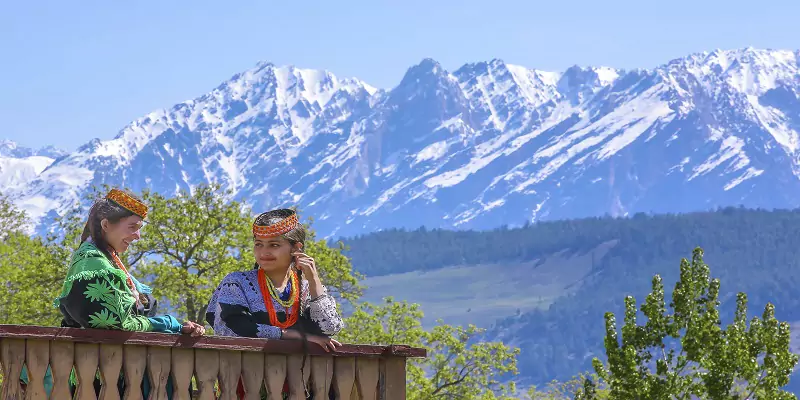Kalash Valley
Kalash Valley, nestled in the picturesque mountains of the Khyber Pakhtunkhwa (KPK) province of Pakistan, is a unique and enchanting destination that captivates visitors with its rich cultural heritage, stunning landscapes, and the vibrant traditions of the Kalash people. In this comprehensive exploration, we will delve into the geography, history, culture, lifestyle, festivals, and the significance of Kalash Valley within the broader context of KPK.
Kalash Valley is situated in the Chitral District of KPK, near the border with Afghanistan. The valley is encompassed by the mighty Hindu Kush mountain range, offering breathtaking views of snow-capped peaks and lush greenery. The region is known for its pristine beauty, with fertile slopes and terraced fields that add to the overall charm of Kalash Valley.
The history of Kalash Valley is shrouded in mystery and folklore. The Kalash people, believed to be descendants of Alexander the Great's army, have inhabited this region for centuries. The valley has witnessed the ebb and flow of various civilizations, contributing to the unique cultural tapestry of the Kalash community. Over the years, Kalash Valley has maintained its distinct identity, standing as a testament to the resilience of its people.
The culture of Kalash Valley is one of the most intriguing aspects of this region. The Kalash people have preserved their ancient traditions, language, and rituals, making them a distinct ethnic and cultural group within Pakistan. The Kalash language, known as Kalasha-mun, is a testament to their unique heritage. The people are known for their vibrant clothing, intricate handicrafts, and a lifestyle deeply rooted in the customs of their ancestors.
The lifestyle of the Kalash people is closely tied to the agricultural cycles of the valley. The terraced fields are used for cultivating crops such as wheat, barley, and maize. The traditional wooden houses, adorned with intricate carvings, dot the landscape, providing a glimpse into the architectural heritage of the Kalash community. The people lead a pastoral life, and their close connection to nature is evident in their daily activities.
Festivals:
Kalash Valley is renowned for its colorful and unique festivals that celebrate various aspects of the Kalash culture. The most notable festivals include:
1. Chilimjusht (Spring Festival):
Celebrated in May, Chilimjusht marks the arrival of spring. The Kalash people, dressed in vibrant attire, participate in traditional dances, rituals, and feasts. The festival is a time of joy and thanksgiving for the abundance of nature.
2. Uchal (Summer Festival):
Uchal, held in late August, is a harvest festival. The Kalash people express gratitude for the bountiful crops through dance, music, and communal feasting. The festivities also include traditional games and competitions.
3. Choimus (Winter Festival):
Choimus, celebrated in December, is one of the most significant festivals. The Kalash people welcome the winter season with bonfires, dance, and rituals. It is a time for community bonding and reflection.
Religion:
The Kalash people follow a unique polytheistic religion known as Kalash mythology. They believe in a pantheon of gods and goddesses associated with various natural elements. The spiritual practices and rituals are an integral part of their daily lives, and the religious ceremonies are performed by designated individuals within the community.
Tourism:
Kalash Valley, with its cultural richness and scenic beauty, has become a popular tourist destination. Visitors from within Pakistan and around the world are drawn to the valley to witness the unique customs of the Kalash people, explore the mesmerizing landscapes, and experience the warmth of the community. However, the increasing tourism has also raised concerns about preserving the delicate balance of the Kalash way of life.
The Kalash community faces various challenges, including cultural assimilation and external influences. Efforts are being made by both the government and local organizations to preserve the unique heritage of the Kalash people. Initiatives include cultural awareness programs, sustainable tourism practices, and educational endeavors to empower the community.
Kalash Valley holds immense significance within the broader context of Khyber Pakhtunkhwa. It represents the diversity of cultures and traditions that thrive in the province. The preservation of the Kalash way of life is not only crucial for the community itself but also contributes to the rich cultural mosaic of KPK and Pakistan as a whole.
The valley is not only a cultural treasure but also an ecological one. Efforts are being made to implement sustainable practices to protect the natural resources of Kalash Valley. This includes responsible tourism, afforestation projects, and measures to mitigate the impact of climate change on the region.
As Kalash Valley navigates the challenges of modernity and cultural preservation, the future outlook involves finding a delicate balance. Sustainable tourism, community-led initiatives, and ongoing efforts to raise awareness about the importance of Kalash culture are key components of ensuring a thriving future for the valley and its people.
Kalash Valley stands as a living testament to the rich cultural diversity and historical depth of Khyber Pakhtunkhwa. The enchanting landscapes, coupled with the unique traditions of the Kalash people, create an atmosphere that is both captivating and thought-provoking. As the valley continues to attract visitors and face evolving challenges, the importance of preserving the Kalash heritage becomes increasingly paramount, not only for the community itself but for the cultural legacy of Pakistan.

